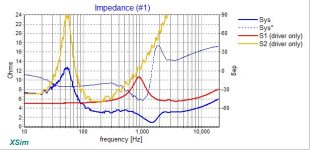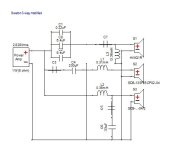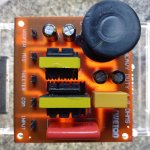Hey there I built my towers without consideration for the crossover and I just need advice before I spend any more money on it!
I have 4- 6 inch aluminum magnesium hi-fi speakers in each box and I need some kind of a crossover to get the sound as good as I can get with a 50 wpc tube amp? Any recommendations??
“They sounded great on the workbench in a series parallel before I even built the box “
I have 4- 6 inch aluminum magnesium hi-fi speakers in each box and I need some kind of a crossover to get the sound as good as I can get with a 50 wpc tube amp? Any recommendations??
“They sounded great on the workbench in a series parallel before I even built the box “
Just those, so no cross but you need EQ?I have 4- 6 inch aluminum magnesium hi-fi speakers in each box
OK - I'm a beginner and her is my crossover question:
I am hacking a commercial crossover to match my 'moderately priced' drivers - the response curve seems OK but what about the impedance?
(red: tweeter yellow woofer1 green woofer2)
thx a.f.d
I am hacking a commercial crossover to match my 'moderately priced' drivers - the response curve seems OK but what about the impedance?
(red: tweeter yellow woofer1 green woofer2)
thx a.f.d
Attachments
How have you wired the four six inch drivers, Series Parallel, to try and give something close to 4 or 8 Ohm overall resitance ?
The midrange is a peerless SDS paper 5" midwoofer ?
Please could you give a bit more info to help us understand what you have got, links to driver data sheets would be very helpful ?
The midrange is a peerless SDS paper 5" midwoofer ?
Please could you give a bit more info to help us understand what you have got, links to driver data sheets would be very helpful ?
Approximately it should work, if you put two 8Ω drivers in parallel that equal the single 4Ω driver.
Last edited:
The crossover seems designed for car use as it's pretty simple. It doesn't incorporate the BSC...as it's not designed for a freestanding box. You should augment LP coil value...
*Baffle Step Correction
*Low Pass
*Baffle Step Correction
*Low Pass
Simulation is burdened with multiple flaws. You did not use hilbert transform for both of the woofers (generates frd and zma phase data ).
Zma of each woofer appears suspicious. Perhaps mistraced.
Crossover components are far away from anything remotely acceptable.
Baffle step is also likely not present.
The whole concept seems wrong.
Was this designed by an AI?
Zma of each woofer appears suspicious. Perhaps mistraced.
Crossover components are far away from anything remotely acceptable.
Baffle step is also likely not present.
The whole concept seems wrong.
Was this designed by an AI?
lojzek said:
Simulation is burdened with multiple flaws. You did not use hilbert transform for both of the woofers (generates frd and zma phase data ).
Zma of each woofer appears suspicious. Perhaps mistraced.
Crossover components are far away from anything remotely acceptable.
Baffle step is also likely not present.
The whole concept seems wrong.
Was this designed by an AI?
AI is about right - Aging Intelligence <g> -
I downloaded the driver specs* used FPGraph to derive the zma and frd files and then used XSim to play around with designs based on cheap xo's available here in Goa (and which are cheaper than buying discrete components***).
My first choice was a 2.5 system (like my Spendors) but the best flat response I could achieve was a 3-way.
I assumed (rightly or wrongly??) that having got a flattish response I didn't need to worry about Baffle Step.
My planned enclosure is a mix of Spendor S5e and Delling - 170mm wide so if my math is correct the baffle frequency is just over 4KHz which is handled almost entirely by the tweeters, and the BFC component values are not much different to the +/- 10% error in my xo stuff.
re Hilbert - I just tried using derived phase values in XSim but it didn't make a lot off difference and is just based on my guess at frequency tails.
*
https://www.parts-express.com/pedocs/specs/297-417-hivi-q1r-spec-sheet.pdf
https://www.madisoundspeakerstore.c...i-vi-q1r-1-fabric-dome-tweeter-116-mm-flange/
*** The downside is that component values are not available and measuring in-circuit is dodgy.
@picowallspeaker:
You should augment LP coil value...
*Baffle Step Correction
*Low Pass
I tried increasing the 0.36 low pass in steps from 0.5 - 3 mH and the response graph got progressively worse.
All practical suggestions are very welcome but please remember this is a fun / learning exercise and I have access to a limited range of components (and ability!). I suppose I can make my own air core chokes - I have a regular supply of loo-roll inners <s>.
Cheers (_)? a.f.d
p.s. starting point:
Simulation is burdened with multiple flaws. You did not use hilbert transform for both of the woofers (generates frd and zma phase data ).
Zma of each woofer appears suspicious. Perhaps mistraced.
Crossover components are far away from anything remotely acceptable.
Baffle step is also likely not present.
The whole concept seems wrong.
Was this designed by an AI?
AI is about right - Aging Intelligence <g> -
I downloaded the driver specs* used FPGraph to derive the zma and frd files and then used XSim to play around with designs based on cheap xo's available here in Goa (and which are cheaper than buying discrete components***).
My first choice was a 2.5 system (like my Spendors) but the best flat response I could achieve was a 3-way.
I assumed (rightly or wrongly??) that having got a flattish response I didn't need to worry about Baffle Step.
My planned enclosure is a mix of Spendor S5e and Delling - 170mm wide so if my math is correct the baffle frequency is just over 4KHz which is handled almost entirely by the tweeters, and the BFC component values are not much different to the +/- 10% error in my xo stuff.
re Hilbert - I just tried using derived phase values in XSim but it didn't make a lot off difference and is just based on my guess at frequency tails.
*
https://www.parts-express.com/pedocs/specs/297-417-hivi-q1r-spec-sheet.pdf
https://www.madisoundspeakerstore.c...i-vi-q1r-1-fabric-dome-tweeter-116-mm-flange/
*** The downside is that component values are not available and measuring in-circuit is dodgy.
@picowallspeaker:
You should augment LP coil value...
*Baffle Step Correction
*Low Pass
I tried increasing the 0.36 low pass in steps from 0.5 - 3 mH and the response graph got progressively worse.
All practical suggestions are very welcome but please remember this is a fun / learning exercise and I have access to a limited range of components (and ability!). I suppose I can make my own air core chokes - I have a regular supply of loo-roll inners <s>.
Cheers (_)? a.f.d
p.s. starting point:
Attachments
Last edited:
The electrolytic caps are put in anti-series to make a non-polarized cap.
The LP coil - whazzat? Is it shielded?
And principally: what kind of speakers are?
The LP coil - whazzat? Is it shielded?
And principally: what kind of speakers are?
@picowallspeaker: Hi - see #13 for speakers, yes anti-series (or on my planned mod anti-parallel =200 uF).
Three chokes - the round one afaik is .36mH the other two .31 mH (mid) and .36 mH (woofer).
There is also a 2.2 polyester cap paralleled with a 0.22 (?x2) - don't ask!
Cheers
Three chokes - the round one afaik is .36mH the other two .31 mH (mid) and .36 mH (woofer).
There is also a 2.2 polyester cap paralleled with a 0.22 (?x2) - don't ask!
Cheers
Last edited:
So 4 woofers are available, then the idea of 2.5 way speakerMy first choice was a 2.5 system (like my Spendors) but the best flat response I could achieve was a 3-way.
I assumed (rightly or wrongly??) that having got a flattish response I didn't need to worry about Baffle Step.
The problem is that the inductors don't stop enough the passage of mid&treble frequencies, so they are quite useless, even in series. Start with ~2mH for 4Ω speaker for woofer usage (LP&EQ) ...just to say a number.
The main problem for going 3 way is the ambiguity between woofer and midrange, since they are the same and are not distinguished by the size which is directly proportional to the size of the wavelength and moreover the frequency requires less mass to move quickly as it rises, so smaller diaphragm.
Not mentioning the crossover that has to manage the three together.
- Home
- Loudspeakers
- Multi-Way
- Crossover questions for the beginner



